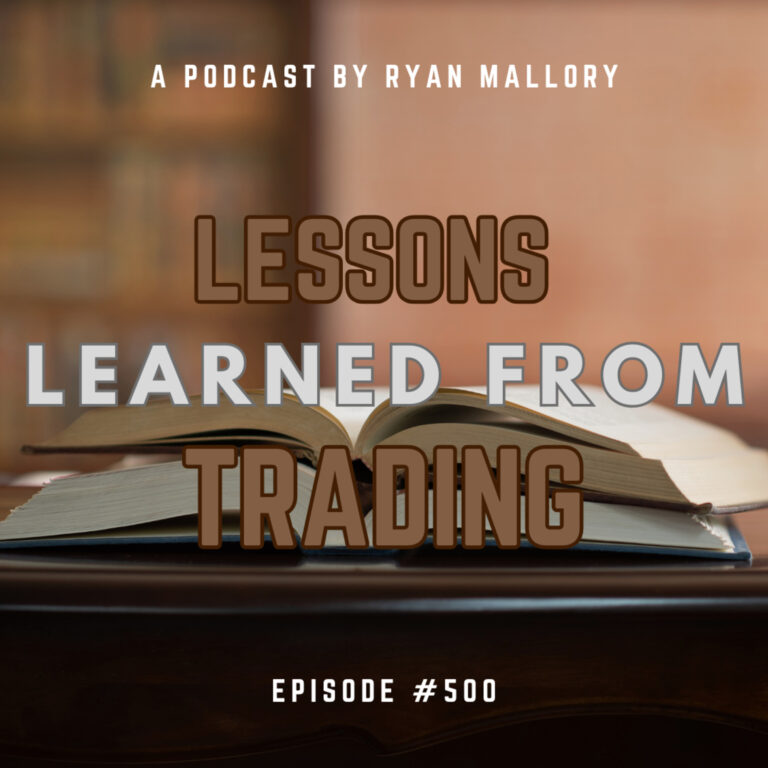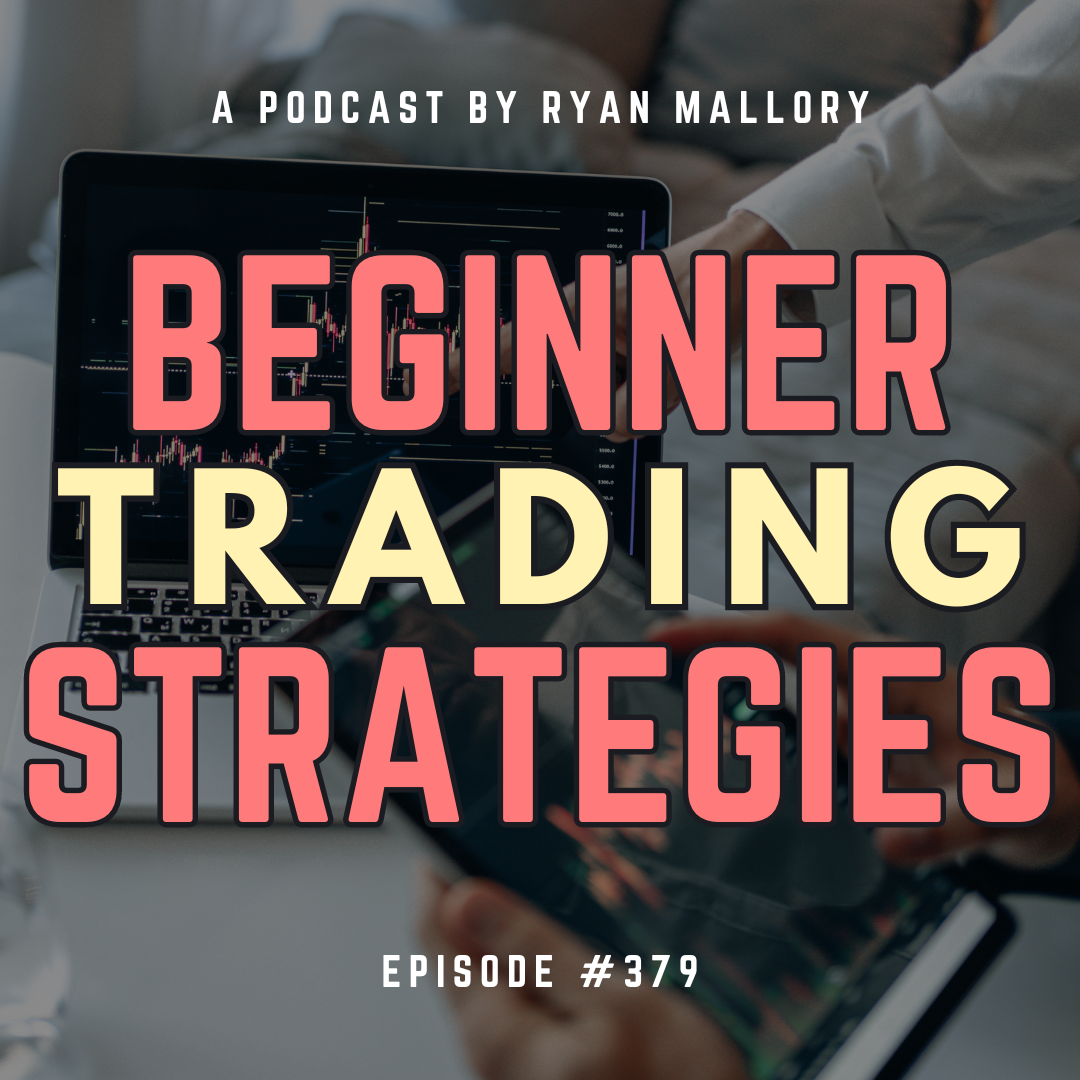Episode Overview
Ryan Mallory provides a couple of swing trading strategies good for beginning traders to incorporate into their swing trading. These are also strategies that Ryan still regularly uses in his own trading too and helps to keep traders from chasing after stocks.
Available on: Apple Podcasts | Spotify | Amazon | YouTube
Episode Highlights & Timestamps
- [0:07] Introduction to the Podcast
Ryan introduces the show and its purpose of helping traders navigate complex markets. - [0:33] Zeke’s Question on Beginner Strategies
Listener Zeke asks about the best technical strategies to start with and shares his early experiences. - [2:33] All Trades Are Breakouts or Bounces
Ryan simplifies strategy selection into two core types: breakouts and bounces off support and resistance. - [4:49] Understanding Basing Patterns and Breakouts
Detailed discussion on how basing patterns lead to breakout setups and what to avoid. - [7:42] Drawing Trend Lines for Bounce Plays
Ryan explains how to draw effective trend lines and why arithmetic charts work best for swing traders.
Key Takeaways from This Episode:
- Focus on Two Strategies: Breakouts from basing patterns and bounces off trend lines are the two best starting points.
- Avoid Chasing Price: Chasing after a 10% move increases risk and often leads to poor entries and stop-outs.
- Use Daily Charts for Base Patterns: Look for patterns that form over weeks or months, not just days.
- Arithmetic Charts Work for Swing Trading: Logarithmic charts are not necessary for trades within a 1 to 2-year time frame.
- Wait for Pullbacks on Gaps: If a stock gaps above resistance, wait for a retest and bounce before entering.
Resources & Links Mentioned:
- Swing Trading the Stock Market – Daily market analysis, trade setups, and insights by Ryan Mallory.
- Join the SharePlanner Trading Block – Get real-time trade alerts and community support.

Take the Next Step:
✅ Stay Connected: Subscribe to Ryan’s newsletter to get free access to Ryan’s Swing Trading Resource Library, along with receiving actionable swing trading strategies and risk management tips delivered straight to your inbox.
📈 Level Up Your Trading: Ready for structured training? Enroll in Ryan’s Swing Trading Mastery Course, The Self-Made Trader, and get the complete trading course, from the foundational elements of trading to advanced setups and profitable strategies.
📲 Join the Trading Community: Sign up for SharePlanner’s Trading Block to become part of Ryan’s swing-trading community, which includes all of Ryan’s real-time swing trades and live market analysis.
Full Episode Transcript
Click here to read the full transcript
0:07
Hey, I’m Ryan Mallory and this is my Swing Trading the Stock Market podcast. I’m here to teach you how to trade in a complex, ever changing world of finance.
0:16
Learn what it means to trade profitably and consistently, managing risk, avoiding the pitfalls of trading, and most importantly, to let those winners run wild.
0:25
You can succeed at the stock market and I’m ready to show you how. Hey everybody, this is Ryan Mallory wood Swing Trading the Stock Market.
0:33
In today’s episode we’re going to talk about beginner trading strategies. I received an e-mail from a guy he asks to be called Zeke so I don’t have to give him a Florida
0:41
redneck name like I give most people because he’s telling me what to call him. Which is quite helpful as well because you start to run out of Florida redneck names after a while.
0:49
Anyways, Zeke wrote Dear Ryan recently found your podcast super stoked to utilize my drive time at work, he says for educational opportunities.
1:03
If this gets to the podcast, feel free to call me Zeke. What’s past tense for swing trading?
1:09
I swing trade in 2021 and enjoyed some beginner’s luck. Well, first of all, I don’t think it’s swing swing trading.
1:17
Swing traded. Just put AD at the end of trade.
1:20
You swing traded stock in 2020 through 2021 and enjoyed some beginner’s luck. OK, that sounds a lot better than swing traded.
1:28
He goes on the right due to other commitments and distractions. I haven’t traded since early 2021.
1:34
I am resetting my mindset and knowledge to get a fresh start and foundation. I am working on a business plan and trading workbook exploring how to scan for stocks that will make
1:44
good swing trades, developing rules and risk ratios etcetera, etcetera. My current question, what are let’s say 3 great beginner trading strategies on the technical
1:56
analysis side of trading, I have read about so many different patterns like flags, pendants engulfing this engulfing that EMA support resistance on and on.
2:08
Essentially once I narrow stocks down, what strategies and what indicators are the most hopeful for them.
2:15
My hypothesis is that I should trade about two to three strategies until my pattern recognition becomes very strong and my understanding of the charts story.
2:23
Sincerely Zeke, All right, good e-mail from Zeke there a lot to go over here. One thing that I would say when it comes down to trading and particularly with technical analysis,
2:33
you’re really talking about all the different trading strategies. I guess I’m trying to say boils down to really just two types of trades, bounce plays and breakouts,
2:41
right? Either a stocks breaking out that you’re trading or it’s playing a bounce.
2:45
Rarely do you really want to get into the middle of a move where a stock is already underway on a breakout or has already bounced 5 or 10% and you’re just now getting along with no reason to get in
2:57
for it except for the fact that the stock is going up. If you’re looking at it from a trading standpoint and trying to manage the risk, really what you’re
3:03
really playing is breaks of support and resistance or where support and resistance is holding.
3:11
And then in the instances where support and resistance holds, you’re playing the bounces off of them.
3:15
So you’re playing a bounce off of support or you’re fading off of resistance. And so becoming very accustomed with the various types of support.
3:22
You got trend lines, you got price level supports, and those are probably your two main ones. I mean, support resistance can show up in different ways, but those are your two main categories.
3:31
And when you’re playing a breakout, for instance, you’re playing a breakout of like a declining trend line to the upside cuz it’s breaking at an existing trend or you’re playing a basing pattern
3:40
at the lows and it’s starting to finally break out. Now doesn’t mean that the only breakouts happen at the very end.
3:46
Like he mentioned, there’s bull flags and other things where you can get some consolidation at even all time highs and you can play the breakout there, but it’s usually coming out of a pattern, the
3:56
patterns are breaking. So I get a lot of people that say, well technical analysis doesn’t work because support broke there.
4:02
Just further proof that technical analysis is dead doesn’t work. Well, that’s not true either, because technical analysis doesn’t mean that support and resistance is
4:11
always gonna hold. If that was the case, price would never go anywhere, right?
4:15
It would just always be trading sideways, just contained by support and resistance indefinitely. But when support and resistance breaks, or when it holds, it’s what this chart is trying to tell
4:24
you. What’s the story there?
4:25
It means that it’s breaking out of the confines of resistance. When it breaks through to the upside.
4:30
It means that sellers are gaining control of the stock to the downside when it breaks through key support, that there’s not enough buyers to hold up that stock any longer like it had in the past.
4:38
And So what I would tell Z Care is he asks me what are 3 great beginning trading strategy. And really I would narrow it down to two breakouts and basing patterns.
4:49
Okay.
4:50
That’s one.
4:51
So breakouts you’ll see oftentimes a stock, it, it takes a big hit. It starts to base for a long time and then it breaks out of that base.
4:57
You go back to the beginning of January. NVIDIA did that.
5:00
A number of stocks did that and they went on like 60-70 hundred percent runs, right?
5:09
So you have basing patterns and then you have price breaking out of those basing patterns and
5:14
sometimes your basing patterns. They can stretch over many, many months, or sometimes they can stretch over the course of a couple
5:19
weeks. I’m not really crazy about a basing pattern that’s only taking place over the couple of days or a
5:24
few days. You have to usually go to an intraday chart to even see anything remotely similar to a basing
5:29
pattern. But on a daily chart, if you can get something that’s formed over the course of a few weeks to a
5:35
couple of months, that’s pretty nice. Now if you get one that’s been trading at its lows for a long time, let’s say it goes back like a
5:40
year or two, yeah, I don’t know how strong of a base breakout that’s going to be. It could move.
5:47
But usually those bases are are pretty large. You’re talking about maybe like 20 or 30% of the range that it’s trading in.
5:54
So if it breaks out, you’re not necessarily going to get usually a major move right away because of how long it took for that pattern to develop.
5:59
I remember there was this one time where I was like, man, this is like the mother of all inverse
6:04
head and shoulders patterns. It’s a massive pattern.
6:06
I think took like 15 years to form.
6:08
I kid you not, I can’t even remember what stock it was, but it was like 15 years to form this thing
6:12
and I got into it and it did really nothing.
6:14
I got stomped out of it not too long thereafter, but this inverse head and shoulders pattern was so
6:22
big that yes, it finally broke above that technical line or that resistance, the neckline of the
6:28
inverse head and shoulders pattern. And then you’re expecting this explosion to the upside, but it just starts to trade sideways.
6:35
That’s because there’s not a lot of emotion tied to that chart anymore. It’s just it’s taking so long for that pattern to unfold.
6:42
Most people don’t even notice that that’s happening and people weren’t compelled to buy it. When it does breakthrough, that resistance as being a change in the behavior of the stock.
6:46
So I remember I got stopped out of it. I thought this was like the mother of all inverse head and shoulders pattern.
6:53
But because it took so long to develop, like 15 years, is anybody really noticing it at that point? Does anybody even care if they do notice it?
6:59
I care it at the time, but I don’t think anybody else did. Otherwise, I would have had a lot more buyers getting behind me on that trade.
7:01
One thing though that I hope that you notice is swingtradeinstockmarket.com. swingtradeinstockmarket.com is the website that goes alongside of this podcast.
7:08
This is where you can go to get all my stock market research each and every day for a nominal price and very affordable.
7:14
Check it out. You’re gonna get everything from daily watch lists, master watch list updates each week.
7:20
Plus you’re going to get updates on all the big tech stocks a few times a week and stock market
7:26
updates as well. Really cool. I even review the trades that I put in the watch list later in the afternoon.
7:30
Some really good stuff to check out to be familiar with and you’ll learn a lot too throughout the process of being a member of swingtradingthestockmarket.com as well as supporting the podcast.
7:39
So check that out. swingtradingthestockmarket.com.
7:42
The other strategy that I would say to become familiar with is drawing trend lines. Now I take some heat every once in a while on Twitter or StockTwits because I post a chart that use
7:53
arithmetic lines. Essentially the price levels are evenly spaced out.
7:57
People are like, oh you should be using log charts. That’s the one that you should be using.
8:01
I don’t care to use log charts, honestly I’ve I’ve used them in the past and I have had far more success using arithmetic charts.
8:07
And the reason why is because swing trading is not so much an approach to the market where you’re looking at 15–20 year trends.
8:14
Yes, they might happen to come into play every once in a while, but like I was saying with the inverse head and shoulders pattern usually doesn’t work in the time frame for what you’re using
8:21
swing trading for. So for me, most of my charts, I’m looking probably back year, year and a half for the most part.
8:29
You know, sometimes I might go back two years, but more times than not, about a year is what I’m looking at on the chart.
8:34
So I don’t need to use those log charts for that. And if a stock has moved two or three 100%, I still want to use an arithmetic chart anyways.
8:43
I mean, if I’m going back and I’m trying to trade the S&P 500 going back to 1980, yeah, I would use a log chart for that.
8:49
But I’m not, I don’t, I don’t use that at all. So I don’t use log charts and and some people may disagree.
8:54
Some people listening will probably disagree with me on that and that’s fine. I’ve never said that my approach is the only approach to successful trading.
9:01
It’s not. There’s plenty of other avenues and stuff and some people will use log charts and be just fine using it.
9:06
I just choose not to use log charts.
9:08
But the trend lines are important, especially from alongside. You’re looking for higher highs and higher lows and then you wanna see where you can draw a line
9:14
from each one of those lines connecting it, cuz then that tells you where price can pull back and you can play the bounces off of those lines off of those support levels, rising support levels as I
9:23
like to often call them. And so you can play those bounces.
9:26
Now the reason why I like these for beginning strategies and I don’t think they’re necessarily limited to just beginners.
9:31
I think I use them all the time. I use them plenty of times.
9:35
Breakouts are important when they’re coming out of a base and trend lines when they’re holding the trend line and bouncing.
9:40
That can be for some good opportunities as well. But one of the things that I like about the two approaches that I just told you about is that both
9:46
will keep you from chasing stocks. If you’re not getting the base breakout in the early stages, well, you definitely don’t want to do
9:52
it after it’s already moved 10 or 15%. Then if you’re getting in at that point, you’re chasing and then you’re probably exposing yourself
9:59
to some unnecessary risk on trend lines. You’re trying to play the bounce off of the trend.
10:03
You want to see signs that it wants to bounce off of it. And then once it’s showing signs that it can bounce, then that’s where I often times I’m looking to
10:09
get long kind of stock. Like I said, both will keep you from chasing prices unnecessarily.
10:14
Like you go back to 2021 with the GMB craziness and the AMC, which this person was trading in 2021, early 2021.
10:22
So he may have seen a little bit of that Wall Street bet stuff. He definitely saw the craziness of COVID in 2020 when the markets were just totally chaotic in
10:31
March, selling off massively and then rallying sharply back by the end of the year.
10:34
A lot of those moments, especially with the WSB, stocks, the Wall Street bets, plays, there was a lot of chasing going on.
10:40
You like GameStop Home went from like $4.00 to $400.00, and in the middle people were like, oh, I’m gonna buy this at $300.00.
10:45
And yes, it still went up to 480.
10:49
But how many of the people who bought at 300 sold at 480? No, they weren’t looking for a 50 plus percent gain or a 60 plus percent gain.
10:55
They were looking for another 1000% gain. And so a lot of those who bought at like 2 or $300.00 a share, they still lost massively.
11:03
And it’s unfortunate because they had plenty of profits at one point, but because they were trying to do what the people did at four and $5 by chasing it at $300.00, they were delusional and they
11:13
lost a ton of money. I’d also like to mention too, when it comes to base breakouts, often times you may find yourself,
11:19
you know, waiting for that base breakout to take place and you wake up the next morning and it’s gapped above it.
11:24
Or one of the things I like to do is, is to hold off on any trades, the 1st 30 minutes of trading, because it’s a very misleading time in the markets.
11:31
But it’s also during that time where you could get a base breakout of a stock and then it breaks above your line and then it’s off to the races.
11:39
It’s up 5% before the 1st 30 minutes it’s even done. You’re like, should I get into it now or whatever?
11:45
No, what I like to do when that happens, or if there’s a gap above my breakout level, wait for the pullback to the breakout level and then you have a good stop.
11:53
You wait for it to start to bounce. Once it starts to bounce, I put my stop loss below the lows of that where it successfully tested the
12:00
base breakout level where it pulled back to it and held it, and then I put my stop loss below the lows there.
12:04
And then I ride the bounce back up because often times stocks that break out, they’ll usually come back a few days later and retest that breakout level before ultimately going higher.
12:15
And I also like if I’m gonna play a base breakout, I’d like to see some consolidation underneath the base so I can keep a tighter stop loss and by putting that stop loss just below the consolidation.
12:24
So yeah, flags, they’re good. There’s lots of patterns out there engulfing candle patterns like what he mentioned or he mentioned
12:30
engulfing this, engulfing that. Yeah, anytime I’m using candlesticks for trades and stuff, I want it to be part of a larger pattern.
12:36
I want it to be working with a pattern as well. So just remember that in your trading.
12:39
If you enjoyed this podcast episode, I would encourage you to leave me a five star review. I do appreciate everything that you guys say, and kindness, obviously, but leave me those five star
12:50
reviews, They do mean a lot to me. I found out from the Spotify Rap for podcasters that 42% of you are not even in the United States,
12:57
which is kind of cool. I think 90 countries have streamed this podcast over the past year and I’m very thankful for that.
13:04
And so many of you guys have found this podcast and just the past year alone. And if you’re getting going through the episodes one by one, I’d encourage you also to go back into
13:12
the past and listen to some of those. I try to make these things to where whether or not you pick up at the first episode or the last
13:17
episode, you’re learning something regardless. So check them all out and check out swingtradingthestockmarket.com.
13:24
And if you want to have a podcast episode dedicated to your question or something you’re curious about when it comes to the stock market, send me an e-mail ryan@shareplanner.com.
13:34
I do read them all and I make an episode pretty much out of everyone. So thank you guys and God bless.
13:41
Thanks for listening to my podcast Swing Trading the Stock Market. I’d like to encourage you to join me in the SharePlanner trading block where I navigate the stock
13:48
market each day with traders from around the world. With your membership, you will get a seven day trial and access to my trading room including alerts
13:56
via text, e-mail and WhatsApp. So go ahead, sign up by going to shareplanner.com trading block that’s www.shareplanner.com/tradingblock
14:06
and follow me on SharePlanners, Twitter, Instagram and Facebook where I provide unique market and trading information every day.
14:14
If you have any questions, please feel free to e-mail me at brianshareplanner.com. All the best to you and I look forward to trading with you soon.
Enjoy this episode? Please leave a 5-star review and share your feedback! It helps others find the podcast and enables Ryan to produce more content that benefits the trading community.
Have a question or story to share? Email Ryan and your experience could be featured in an upcoming episode!
Become part of the Trading Block and get my trades, and learn how I manage them for consistent profits. With your subscription you will get my real-time trade setups via Discord and email, as well as become part of an incredibly helpful and knowledgeable community of traders to grow and learn with. If you’re not sure it is for you, don’t worry, because you get a Free 7-Day Trial. So Sign Up Today!

Welcome to Swing Trading the Stock Market Podcast!
I want you to become a better trader, and you know what? You absolutely can!
Commit these three rules to memory and to your trading:
#1: Manage the RISK ALWAYS!
#2: Keep the Losses Small
#3: Do #1 & #2 and the profits will take care of themselves.
That’s right, successful swing-trading is about managing the risk, and with Swing Trading the Stock Market podcast, I encourage you to email me (ryan@shareplanner.com) your questions, and there’s a good chance I’ll make a future podcast out of your stock market related question.
In today's episode, at episode 500, I am diving into the lessons learned from trading over the last 100 episodes, because as traders we are evolving and always attempting to improve our skillset. So here is to episode 500, and to another 500 episodes of learning and developing as swing traders in the stock market!
Be sure to check out my Swing-Trading offering through SharePlanner that goes hand-in-hand with my podcast, offering all of the research, charts and technical analysis on the stock market and individual stocks, not to mention my personal watch-lists, reviews and regular updates on the most popular stocks, including the all-important big tech stocks. Check it out now at: https://www.shareplanner.com/premium-plans
📈 START SWING-TRADING WITH ME! 📈
Click here to subscribe: https://shareplanner.com/tradingblock
— — — — — — — — —
💻 STOCK MARKET TRAINING COURSES 💻
Click here for all of my training courses: https://www.shareplanner.com/trading-academy
– The A-Z of the Self-Made Trader –https://www.shareplanner.com/the-a-z-of-the-self-made-trader
– The Winning Watch-List — https://www.shareplanner.com/winning-watchlist
– Patterns to Profits — https://www.shareplanner.com/patterns-to-profits
– Get 1-on-1 Coaching — https://www.shareplanner.com/coaching
— — — — — — — — —
❤️ SUBSCRIBE TO MY YOUTUBE CHANNEL 📺
Click here to subscribe: https://www.youtube.com/shareplanner?sub_confirmation=1
🎧 LISTEN TO MY PODCAST 🎵
Click here to listen to my podcast: https://open.spotify.com/show/5Nn7MhTB9HJSyQ0C6bMKXI
— — — — — — — — —
💰 FREE RESOURCES 💰
— — — — — — — — —
🛠 TOOLS OF THE TRADE 🛠
Software I use (TC2000): https://bit.ly/2HBdnBm
— — — — — — — — —
📱 FOLLOW SHAREPLANNER ON SOCIAL MEDIA 📱
*Disclaimer: Ryan Mallory is not a financial adviser and this podcast is for entertainment purposes only. Consult your financial adviser before making any decisions.





